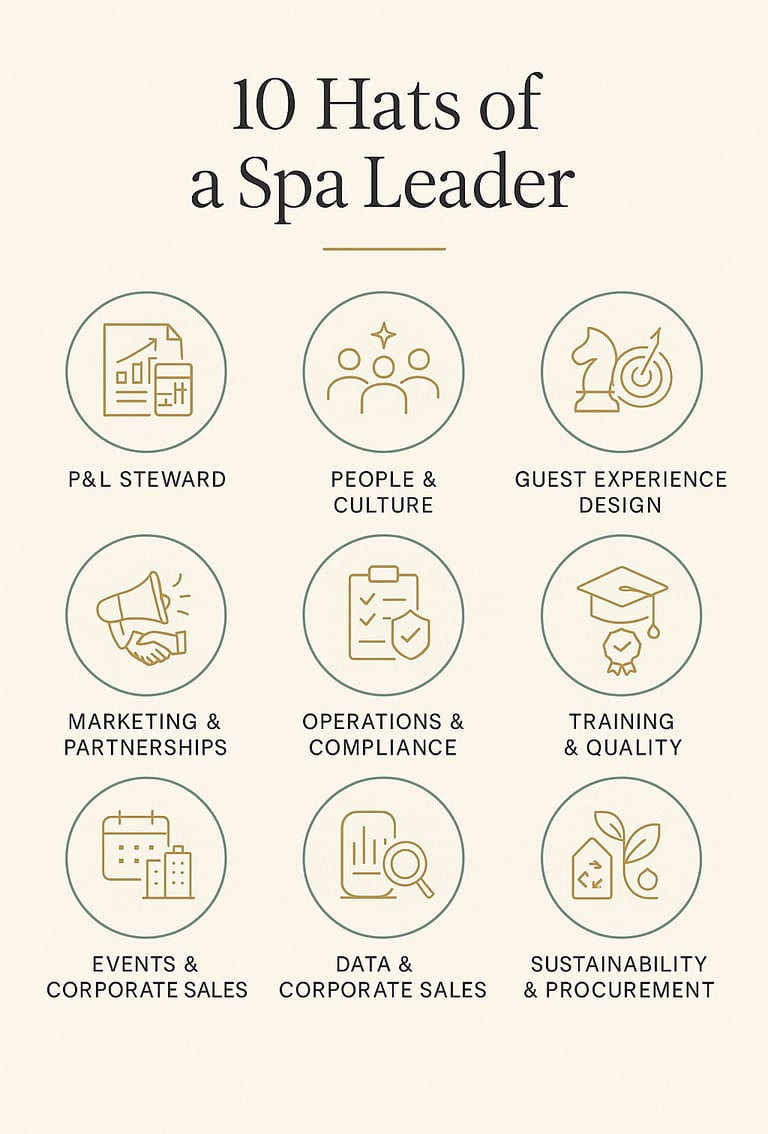Spa Leadership Playbook: 10 Hats That Drive Results
A practical guide for spa leaders on P&L, people, guest journeys, and revenue strategy. Use these steps to improve performance and experience.
Daryn B
9/8/20254 min read


Airlines do not ask CFOs to fly the plane. Great spa leaders do not need to perform treatments. The job is orchestration of brand, numbers, and human care. When that orchestra plays well, revenue grows, teams stay, and guests return.
Why this matters
A spa is not an amenity. It is a business unit that shapes brand perception and total hotel performance. Leaders who treat it this way build predictable revenue, protect margin, and turn first-time guests into loyal advocates.
Below are the ten hats that every high-performing spa leader wears, along with one key metric and one practical move for each.
1) P&L steward
Focus: Pricing, cost control, and profitability.
Metric: Contribution margin by service category.
Action: Build a simple weekly dashboard with revenue, payroll percent, product cost, and no-show rate. Review it with your supervisor every Monday.
2) People and culture lead
Focus: Hiring, fair pay models, recognition, and burnout prevention.
Metric: Voluntary turnover and average therapist hours at target utilization.
Action: Create a 15-minute weekly check-in rhythm. Ask three questions: what worked, what blocked you, and what support do you need.
3) Guest experience designer
Focus: Multi-sensory journeys that feel curated, not generic.
Metric: Rebook rate within 30 days.
Action: Map the guest journey on one page from booking to follow-up. Remove one friction point this week. For example, pre-select robe size or scent on the confirmation page.
4) Revenue strategist
Focus: Yield, packaging, memberships, and upsell flow.
Metric: Retail per guest and attach rate for enhancements.
Action: Design one signature package for each key guest type. Example: “Jet Lag Reset” with a timed add-on offer at check-in.
5) Marketing and partnerships
Focus: Storytelling, digital funnels, PR, and local alliances.
Metric: Cost per booking from each channel.
Action: Create one quarterly partner offer with a nearby brand. Cross-promote to both databases with a clear call to action.
6) Operations and compliance
Focus: SOPs, safety, inventory, and clean handovers between shifts.
Metric: Stock variance and incident frequency.
Action: Introduce a two-minute “reset” checklist for rooms. One standard for layout, light, scent, music, and sanitation.
7) Training and quality
Focus: Consistent delivery and confident upsell.
Metric: Mystery shop score and enhancement conversion.
Action: Run a monthly 30-minute skill sprint. One protocol, one phrase bank for soft-sell language, one micro-assessment.
8) Data and insights
Focus: Read the numbers and act.
Metric: Capture rate from hotel guests and therapist utilization by hour.
Action: Segment demand by day and hour. Shift rosters to the demand curve. Stop overstaffing slow zones.
9) Events and corporate sales
Focus: Groups, retreats, VIPs, and local corporate wellness.
Metric: Group revenue per available hour on off-peak days.
Action: Build two midweek group products with fixed pricing and a simple booking flow. Pitch them to three local companies this month.
10) Sustainability and procurement
Focus: Product integrity, waste reduction, and responsible sourcing.
Metric: Cost per treatment basket and waste per room reset.
Action: Standardize treatment baskets. Buy in tiers, not one-offs. Track variance weekly.
A one-week mini plan
Day 1: Publish your one-page P&L dashboard and agree on three targets with your GM.
Day 2: Map the guest journey and remove one friction point.
Day 3: Launch one signature package with a timed enhancement offer.
Day 4: Run a 30-minute skill sprint on language that lifts retail and rebook.
Day 5: Adjust rosters to demand. Protect therapist breaks to reduce burnout.
Day 6: Set the room reset checklist and audit three rooms.
Day 7: Send two partnership emails and one corporate group pitch.
Common pitfalls to avoid
Full leader calendars in treatment rooms. No time to lead means no time to grow.
Discounting without math. Protect margin by pairing value adds with yield control.
Manual scheduling. Use rules that align people to demand and skills.
Training without practice. Every script needs repetition, coaching, and measurement.
Simple language that sells without pressure
Guests dislike hard sells. Teach your team soft prompts that feel like care.
“Based on your goals, would you like me to add a scalp ritual at the end or save it for next time?”
“Can I set a reminder for your follow-up in three weeks so we build on today’s results?”
What good looks like
A busy Saturday at a coastal resort. Roster matches demand. Rooms reset in two minutes. Therapists have two micro-breaks each. Front desk offers a signature add-on at check-in. Service ends with a clean product suggestion and a rebook offer. The leader reviews the dashboard at close. No drama. Strong day.
Take this with you
A spa leader’s work is orchestration. Not every instrument at once, but the right two or three, played in rhythm. Pick the hats that matter now, set one metric for each, and create a weekly review you never miss. Small, steady improvements turn into higher capture, stronger teams, and guests who rebook without being asked. When the system is designed, the numbers follow.
Start this week: choose two hats, define one action and one metric for each, and review results on Friday. Do it again next week. In 30 days you will see movement. In 90 days you will feel it in margin, loyalty, and the way your brand is experienced. That is leadership guests can feel and owners can measure.


Further reading on our blog: 'Wellness Amenities ROI for Hotels and Estates.'
Do you want a numbers-first concept for your property or estate? Book a feasibility session with Luxe Wellness Spaces. We will provide a concept, budget ranges, and a 12-month activation plan aligned to your revenue model.
About The Author
Daryn Berriman is the Founder and Principal Consultant of Luxe Wellness Spaces, a consulting-led studio blending operational expertise and design excellence to create wellness businesses that perform, and spaces that guests love.


